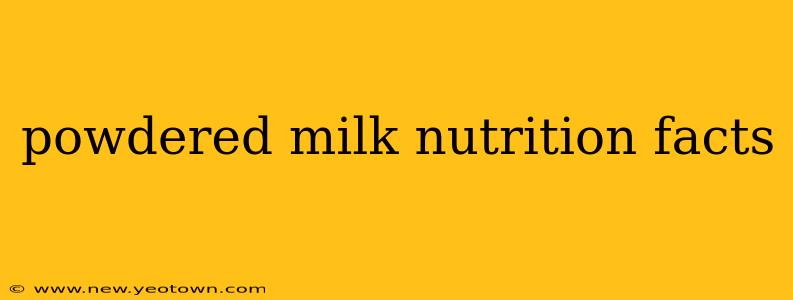Powdered milk. The stuff of childhood memories, camping trips, and emergency preparedness kits. But beyond its convenience, what's the real nutritional story behind this dried dairy product? Let's explore the nutritional facts of powdered milk, delve into its various types, and address some frequently asked questions.
What are the nutritional benefits of powdered milk?
Powdered milk, whether whole, skim, or a blend, packs a nutritional punch. It’s a surprisingly good source of protein, vital for building and repairing tissues, and calcium, crucial for strong bones and teeth. It also provides essential vitamins and minerals, varying slightly depending on the type and brand. Think of it as a concentrated dose of dairy goodness, easily stored and prepared. One serving can contribute significantly to your daily recommended intake of these important nutrients. For instance, a cup of reconstituted skim milk powder often boasts a higher protein content compared to fresh skim milk.
How does powdered milk compare to fresh milk nutritionally?
This is a common question, and the answer is nuanced. Generally, the nutritional profiles are quite similar, with minor variations. The drying process involved in making powdered milk can cause some slight nutrient loss, particularly heat-sensitive vitamins like vitamin C and some B vitamins. However, many brands fortify their powdered milk to compensate for these losses, bringing the nutritional value closer to that of fresh milk. It's important to check the nutrition label of your specific brand to compare effectively. The biggest difference often lies in the fat content, with options ranging from fat-free to whole milk equivalents.
What are the different types of powdered milk?
The powdered milk world is more diverse than you might think! You'll find:
-
Whole milk powder: This retains the fat from the original milk, providing a richer flavor and higher calorie count.
-
Skim milk powder: With the fat removed, it's lower in calories and fat, making it a popular choice for those watching their weight.
-
Instant milk powder: This is specially processed to dissolve easily in cold or lukewarm water, ideal for quick preparation.
-
Sweetened condensed milk powder: This contains added sugar, offering a sweeter taste but significantly increasing the sugar content.
Remember, the nutritional content varies based on the type chosen.
Is powdered milk as healthy as fresh milk?
The healthiness of powdered milk compared to fresh milk is a matter of degree, not a binary choice. While fresh milk might retain slightly more of certain heat-sensitive vitamins, many powdered milk brands are fortified to make up for these losses. Fresh milk, of course, has the advantage of no processing steps. However, powdered milk offers unbeatable convenience, portability, and extended shelf life, making it a great option for various situations. Ultimately, both can be part of a healthy diet.
What are the potential downsides of using powdered milk?
While generally safe and nutritious, some potential downsides exist. Some individuals may experience digestive discomfort, particularly if they are sensitive to lactose. Also, the higher concentration of nutrients in powdered milk means that overconsumption could lead to exceeding daily recommended intakes. Always check the nutritional label and consume in moderation. Additionally, the taste might be slightly different compared to fresh milk, though this varies between brands.
Does powdered milk contain added sugars?
This depends entirely on the type of powdered milk. Plain powdered milk, whether whole or skim, should not contain added sugars. However, sweetened condensed milk powder is specifically formulated with added sugar, significantly raising the sugar content per serving. Always check the ingredient list and nutrition label to confirm the sugar content.
In conclusion, powdered milk offers a convenient and nutritious alternative to fresh milk. Its nutritional profile is comparable, with variations mainly stemming from the drying process and added sugars in certain varieties. By understanding its pros and cons and selecting the right type for your needs, you can harness the benefits of this versatile dairy staple.

